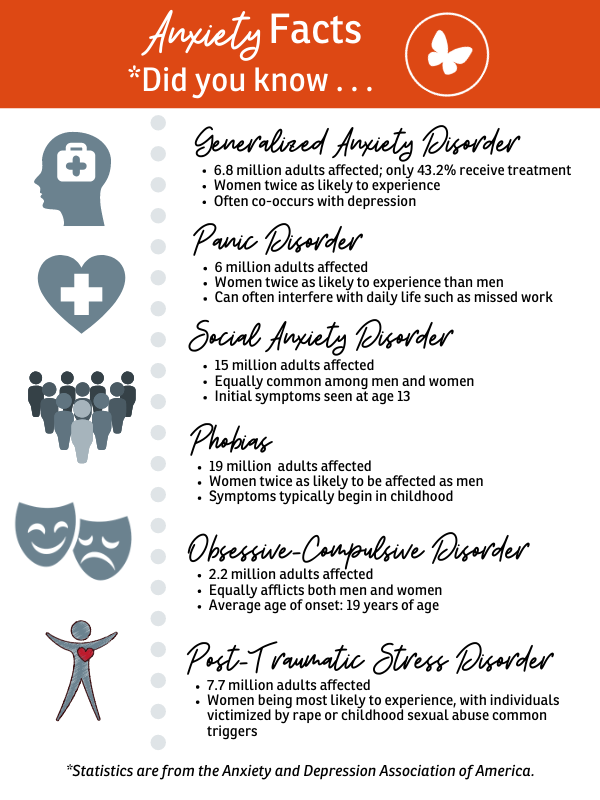When Does Typical Worry Give Way to an Anxiety Disorder

Everyone has some level of stress or temporary worry in their life. However, when worries or nagging feelings which were once typical occurrences become more frequent and interfere with day-to-day routines or activities, an anxiety disorder may be present.
Anxiety Defined
Anxiety is an emotion characterized by feelings of tension, worried thoughts and physical changes, according to the American Psychological Association. For an individual with an anxiety disorder, the anxiety does not dissipate over time and worsens without attention, explained Monarch Behavioral Health Therapist Chalonda Coleman, MSW, LCSW, LCASA, who is based in the Lumberton Facility-Based Crisis Center.
Anxiety disorders are among the most common mental illnesses in this country with over 21 percent of adults (approximately 42.5 million people) affected by the debilitating illnesses each year, as cited by Mental Health America (MHA). Children are susceptible as well with 25.1 percent of youth between 13 and 18 years old affected by an anxiety disorder. According to the Anxiety and Depression Association of America, if left untreated, children with anxiety disorders are at a higher risk for poor academic performance, missed social experiences and possible substance use.
Types of Anxiety
Several different types of anxiety are outlined by MHA:
- Generalized anxiety disorder – excessive anxiety and worry about a number of life events for at least six months. Symptoms can include restlessness, feelings of being on edge, easily fatigued, difficulty concentrating or mind going blank, irritability, muscle tension and sleep disturbances.
- Panic disorder – panic attacks, sudden feelings of terror that can strike repeatedly without warning such as chest pain, heart palpitations, shortness of breath or dizziness, among others.
- Social anxiety disorder – A marked and persistent fear of one or more social or performance situations in which a person is exposed to unfamiliar people or to possible scrutiny by others. An individual may fear that visible symptoms will result in humiliation or embarrassment.
- Phobia – extreme, disabling and irrational fear of something that in reality poses little or no threat or actual danger.
- Obsessive Compulsive Disorder – repeated, intrusive and unwanted thoughts or rituals that seem impossible to control.
- Post-Traumatic Stress Disorder – An individual has been exposed to a traumatic event in which the following were present: the person experienced one or multiple events involving an actual or threatened death, or serious injury, and a threat to the physical integrity of self or others with a response of fear, helplessness or horror.
Post-traumatic symptoms can include flashbacks, vivid memories, recurring dreams or distress when exposed to circumstances resembling the event. General symptoms  may include: difficulty falling or staying asleep; irritability or outbursts of anger; difficulty concentrating, hyper-vigilance or an exaggerated startle response.
may include: difficulty falling or staying asleep; irritability or outbursts of anger; difficulty concentrating, hyper-vigilance or an exaggerated startle response.
Depending on the type of anxiety, symptomatic behaviors can be wide ranging from fatigue, sleep problems and irritability to heart palpitations, feelings of being out of control or sweating, among others. Coleman said there may be reasoning behind who struggles with an anxiety disorder with researchers finding that genetic background and environmental factors can both contribute to the risk.
She added that it is not uncommon for anyone with an anxiety disorder to also be dealing with depression, or eating, sleeping or substance use disorders.
Anxiety Disorders vs. Anxious Behaviors
Coleman explained that anxiety disorders differ from normal feelings of nervousness or anxiousness because excessive fear or anxiety is involved. “A way to alleviate anxiety is to train ourselves to respond to the thoughts and physical symptoms differently,” Coleman said.
Typically, stress is a proportional reaction to a stressful situation or external pressure. “It is completely acceptable, and sometimes an advantage, to feel apprehensive about an important job interview or test that you are taking,” Coleman said. “An anxiety disorder occurs when there is a feeling of heightened apprehension or unexplained thoughts of impending doom. It would be beneficial to anyone struggling with similar kinds of reactions to seek guidance from a health care professional.”
Ways to Treat Anxiety
Coleman noted that treatment depends on the type of anxiety disorder and the individual’s preferences. For lesser forms of anxiety, self-treatment such as stress management or relaxation techniques may provide relief.
For more severe anxiety disorders, psychological counseling and therapy such as cognitive behavioral therapy which alters harmful thought patterns triggering an anxiety disorder, can alleviate symptoms. Coleman said medications can be prescribed to control an anxiety disorder.
Key ways to prevent an anxiety disorder is to keep emotions in check, self-care, maintain a nutritious diet, practice good sleep hygiene and consume less caffeine and alcohol.
Posted on: Thursday January 30, 2020
